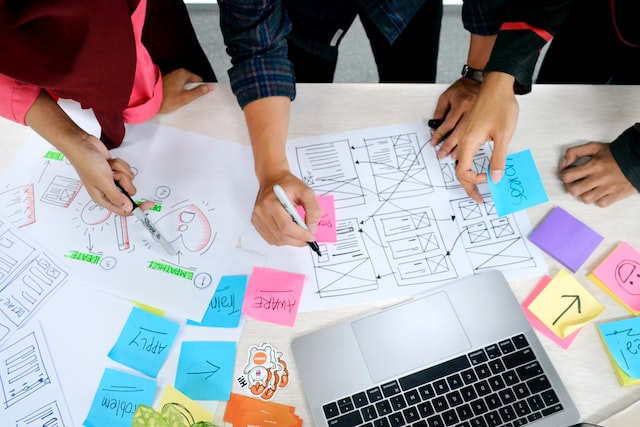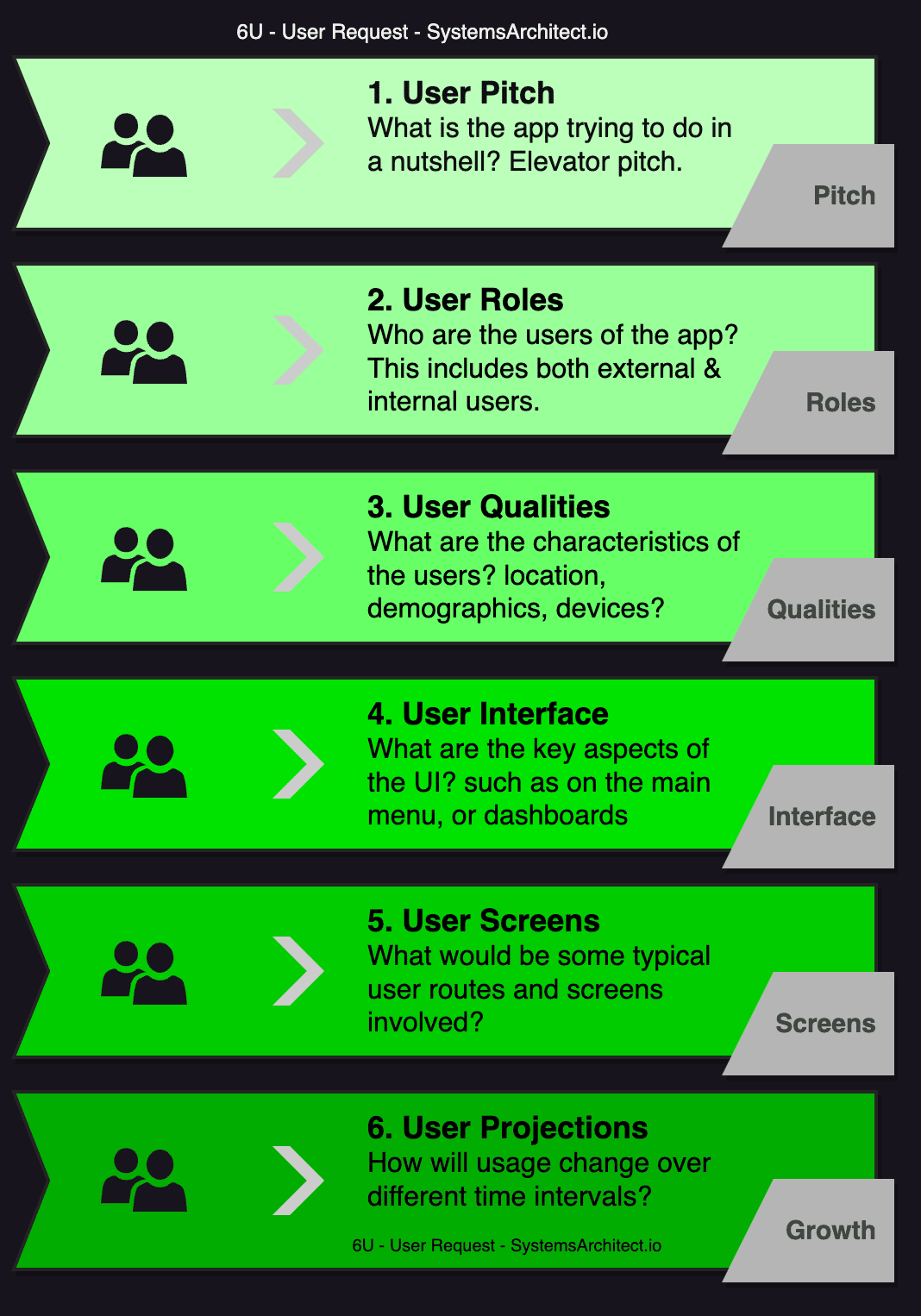 Introduction
Introduction
An initial Request is handled by the systems architect to get a general understanding of the application.
We take a User-focused approach, asking 6 overlapping User-related questions.

The 6 U's - User-focused Request
tip
- Meeting types for Request:
- Initial: 30-45 minutes informal "heads-up", to get basics. Less invitees.
- Extended (1-2mo. followup): 60 minute meeting + in-depth + more invitees.
- Business Functional Document (3-4 mo.): 60 minute review, all involved in it.
- Important: Save the answers and info you get.
- Save the meeting video/recording if possible.
- to review if you forget details, share with colleagues and
- to clear up misunderstandings if changes requested.
- Save the meeting video/recording if possible.

Each one of these is handled in more detail later in this Request category.
- User Story (5 min.)
- What does the app do?
- How: Ask for summary, in 2 minutes or less. App must-haves.
- Why: Highlights main functionality.
- Insights:
- Problem, action, solution, benefit? Organized? Clarity?
- User Roles (5 min.)
- What User roles are needed?
- Roles have Responsibilities which have Requirements
- Roles > Responsibilities > Requirements
- How: Ask for a list of each user/responsibility. Hard requirements/user
- Why: Highlights facets of the app needed, IAM users, must-haves per user.
- Insights:
- Admin? Multiple apps? Auth, User data requirements. Must-haves. ie. compliance, tax etc.
- User Qualities (5 min.)
- What are the user characteristics ie. number, usage patterns, locations, devices, etc.
- How: Ask for list of demographics, location, devices, other relevant user info.
- Why: More info on who is using the app, for device and location.
- Insights:
- Number of users, availability needed, locations, devices, time-usage patterns
- User Interface (5 min.)
- 5 items on the nav bar, home screen, importance of the interface/latency.
- How: Ask for mockup or design vision.
- Why: Highlights most important parts of the app.
- Insights:
- Qualify the most important frontend/user-facing functions of the app.
- Helps us understand interface and importance for this app (some internal apps may be lower priority, others very high)
- User Screens (10-15 min.)
- Drill down into screens for each main function.
- How: Ask for list of what main screens there are and what they do.
- Why: More detail so we can start thinking about data models and APIs.
- Insights:
- More details for data modeling and API design/contracts.
- Helps guage complexity for number/type of features/options available to the user.
- User Growth (10-15 min.)
- Projections of near-future user growth
- How: Ask for some of the daily user requirements and expected growth at 1-2-3-6-9-12 months
- Why: Right-size our architecture, consider scalability, availability and other factors post-launch.
- Insights:
- Start thinking about number, type, complexity, and staffing of resources needed in the next year. At this point only gathering impressions.
- Look for red flags due lack of planning for projected growth.
- A system is normally not built for launch day requirements only, but ongoing growth/usage.
Additional thoughts:
- Can you just email out these questions?
- No, it's recommended to have a live zoom/video, phone or in-person meeting.
- Most product managers/owners are more receptive to a meeting.
- An email may be overwhelming, forgotten, ignored, de-prioritized.
- An email may miss key details that can be asked in the meeting
- This could be shortened to 30 minutes for a brief meeting.
- 45-60 minutes is usually about right to get into enough detail.
- Ask a lot of questions (examples below), as finding issues upfront saves effort and misunderstandings later.
- Get initial impressions
- Look for red flags (below)
Invitees for Extended Systems Design Meeting
- There can be an initial meeting with only one or a few roles mentioned below.
- However, if some can be present it helps to get awareness and "buy-in" earlier in the process.
- Extended (followup) meeting is when more gaps have been filled in a and it's closer to the final Business Functional document.
An extended Functional Document kickoff meeting should include representation for these roles:
| Role | Responsibility |
|---|---|
| Product Owner/Product Manager | Responsible for the overall vision and strategy for the product or feature being discussed. |
| User Researcher | Researching the needs and behaviors of the users of the product. |
| UX/UI Designer | Designing the user interface and user experience of the product. |
| Systems/Solutions Architect | Technical design of the software and system for the product or feature. |
| Tech Lead | Lead for technical implementation. |
| Systems/Software Engineers | Technical implementation of the product or feature. May require multiple roles for specialties like Database, DevOps, Network. |
| Business Analyst | This person is responsible for analyzing the business requirements and goals of the project. |
| Quality Assurance/Tester | Responsible for testing the product or feature to ensure it meets the requirements and is free of defects. |
| Project Manager | Responsible for managing the schedule and resources for the project. |
❌ Red flags (risks) in "Request" phase meetings.
- These are "red flags", risks, if not considered early in the systems design process.
- Address issues in extended or final business decision meetings.
| Potential Problem | Reason |
|---|---|
| Lack of clear goals/objectives for the project | Success requires clear goals, requirements and success measurements. |
| Unclear agenda or schedule | There should be a clear agenda and schedule, outlining what will be discussed, who will be responsible for specific tasks and when decisions will be made. |
| Lack of collaboration and communication | There should be a culture of collaboration and communication. All stakeholders should be encouraged to share their ideas and feedback. |
| No user research | Research is needed to understand the needs and behaviors of the users of the product. |
| No end-users involved | The project needs representation of end-users to give feedback and ideas. |
| No clear product owner | Who is responsible for the overall vision and strategy for the product? |
| Lack of technical expertise | Developers who will be responsible for building the product, particularly for specialized applications like AI, IoT etc. |
| No design representation | UX/UI designers responsible for designing the user interface and user experience may add important insights. |
| Lack of business analysis | The meeting needs representation of the business analysts who are responsible for analyzing the business requirements and goals of the project. |
| No project management | A project manager who is responsible for managing the schedule and resources for the project can help with planning/scheduling. |
| No QA/Testing representation | Quality assurance/testers will be needed at an early stage to plan for testing the product or feature to ensure it meets the requirements and is free of defects. |
| Limited or no discussion of scalability | The meeting should consider how the product will handle increasing numbers of users or data, and have a plan in place for addressing scalability issues. |
| No plan for maintenance and support | The project needs a plan in place for maintaining and supporting the product after it has been released. |
| No consideration of accessibility | The project should consider how the product can be made accessible to users with disabilities and adhere to accessibility guidelines. |
| No discussion of security | The meeting should consider the security risks associated with the product and have a plan in place to mitigate them. |